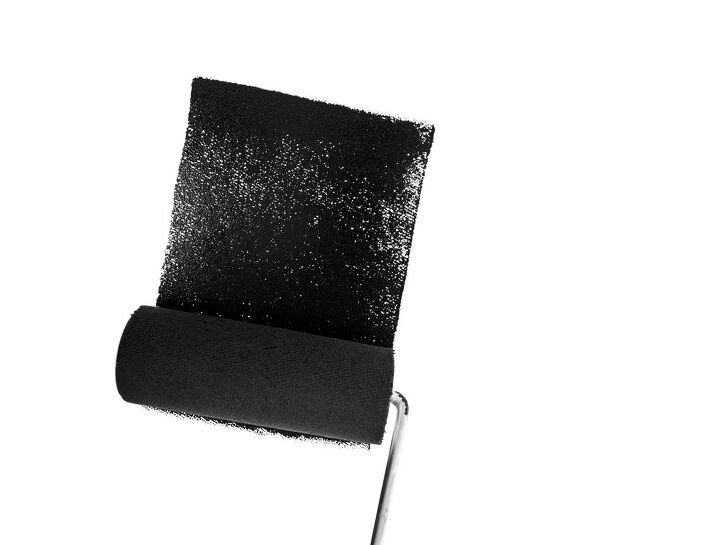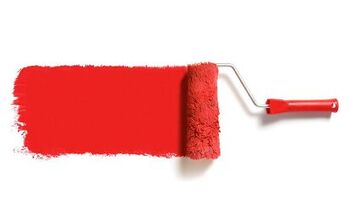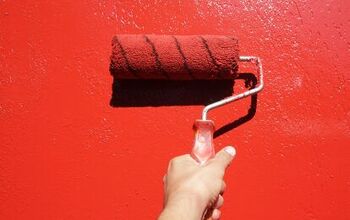What Color Primer To Use For Black Paint? (Find Out Now!)

Painting a wall black is a bold move. So you want to make sure you do it right. Usually, that starts with a healthy coat of high-quality primer. But what color primer do you use for black paint. Better yet, why does it even matter?
In most cases, you should apply gray primer beneath black paint. The current color wall color doesn’t matter. That’s because gray helps create a more solid basecoat than other colors. However, you can also apply tintable primers if you prefer.
Do You Need to Hire a Paint Contractor?
Get free, zero-commitment quotes from pro contractors near you.

Do You Need Primer for Black Paint?
Painting walls a dark color can be tricky. And that’s especially true if your walls are uneven. Primer levels the surface of your walls to produce a smoother finish. So, it’s always a good place to start.
Darker wall colors like navy blue and black can look great if you paint them correctly. You can even buy self-leveling paint or paint and primer in one. However, it’s probably not a good idea to skip the priming step, even if you choose lighter colors.
Meanwhile, coating bare walls with the suitable primer means picking a color that coordinates with your paint. In most cases, that’s gray for black objects. If you’re painting over dark walls with lighter paint, that’s when you use a white primer.
Is There Black Paint Primer?
Primer colors come in different shades to help your walls look professionally painted. You can select white, gray, red, or black primer to cover bare walls. But remember that black paint primer is best for projects you want to make extremely dark.
Black primer is best for painting cars, appliances, and heavy-duty equipment. You can still use it for simple interior or exterior home renovation projects, though. It’s just that your walls may end up darker than you expected.
At the same time, using a black primer may mean fewer coats of paint. In turn, that might affect how long it takes for your walls to dry. And if you choose a color and primer in one, you can get the job done even quicker.
TIP: Use high-quality paint-primer combo products to ensure maximum coverage in the least amount of time.
Can You Use White Primer with Dark Paints?
If you want, you can use a white primer under your black paint. But it may not look as good as it could. While the primer won’t necessarily change the color of your paint, it may alter how it fades and reacts to light. So, stick with gray or black primers for the best results.
Can’t figure out which color paint to use? Consider the pros and cons and think about how black looks with your existing decor. Then, keep your eyes and mind open to new ideas and alternatives just in case.
Does Primer Change the Color of Paint?
Forgetting to prime is a bad idea, but what happens if the primer changes your color? Rest assured that seldom happens. However, if you choose the wrong paint/primer combination, some dyes could bleed through.
For example, you wouldn’t use a red primer beneath white walls because the red is too harsh. And you shouldn’t use a white primer underneath black paint for the same reason. There is one exception, though.
If you want your black paint to pop and appear brighter, cover the walls with a stark white primer first. Doing that will help produce a lighter basecoat and guarantee a more modern finish. For more painting tips, consult a professional.
FACT: Most interior designers can easily recognize and create the perfect color scheme for rooms.
How Many Coats of Primer Do I Need?
It can be a challenge to determine how many coats of primer you need to paint something black. And since black is such a deep, rich shade, mistakes can be hard to correct. That means applying plenty of correctly colored primers is more important than you think.
According to Glidden, one of the top paint brands in the world, you should apply two coats of primer. But bare walls and rough surfaces may require a few more. So, try to sand your walls and surfaces before painting them to save time, money, and energy.
Then, apply your primer liberally and let it dry between coats. The waiting may take a while, though. Depending on the type of primer you use and how many coats you need, expect to wait 1-2 hours between each new layer.
What’s the Best Color Primer for Black Paint?
The best color primer for black paint, regardless of your base color, is gray. And while white or other colors may work, they can change how your paint looks on certain surfaces. Plus, the lighting in your home can affect appearances as well.
So, consider how you want your painted objects to look. Do you mind if the primer bleeds through, or does the finish need to be perfect? And how often will you repaint the thing you’re priming today? The answers to those questions may change the color primer you choose.
For help deciding which option is best, consult an interior decorator or professional painter. Then, look at the color wheel to make sure you’re choosing the right combination. And if all else fails, use a black paint primer to achieve a profound, fool-proof aesthetic.
Pick a Primer, Present Your Paint
Whatever color you pick, it’s going to look great. It’s because you’re applying a primer color that coordinates with your paint. Plus, you’re patiently waiting for it to dry before moving forward. Congratulations on being one step closer to becoming a pro.
Now you know that priming is a crucial step. And you understand why you shouldn’t skip it. Nor should you settle on a color scheme that doesn’t satisfy your tastes. Just because the primer color is a particular shade doesn’t mean your finished product will be.
Instead of panicking, carefully select your paint/primer combination and be open to change if it’s needed. Consult an expert for more information and have some sandpaper ready. It’s time to put some color down.
Do You Need to Hire a Paint Contractor?
Get free, zero-commitment quotes from pro contractors near you.

Related Questions
Does Primer Have to Be Perfect?
Your primer does not have to be perfect. However, try to apply it to the surface evenly. That’s because uneven layers of primer can affect the way your paint job looks. And if there are unsightly spots, you’ll have to sand the surface, then prime and repaint it.Save some time with a self-leveling primer or paint. You can also get a paint/primer in one. Either option lets you make more mistakes without making them obvious. Enhanced primers are excellent products for people with little to no experience painting too.
What Happens If You Don’t Paint Over Primer?
Nothing serious happens if you don’t put paint over your primer. The reason is that primer provides full coverage to the surface. So, it won’t matter much if you skip the next step. However, your surfaces may not look finished if you forget to apply paint.Also, primer and paint adhere to one another when their chemicals bond. And that makes cleaning and maintenance much more manageable. Walls with paint plus primer might become challenging to wash, dry, and maintain. It’s always best if there’s both.Meanwhile, your primer coat could begin to fade more quickly without a layer of protective paint on top. And some colors contain anti-rust or anti-corrosion ingredients to shield your stuff. Therefore, it’s probably a good idea to cover primer with a healthy coat of paint.
Do I Need to Sand Between Coats of Primer?
Some say that sanding between coats of primer makes no sense. Others say it’s a crucial part of the process. But once all your primer layers dry, it’s a good idea to take a quick pass with a piece of sandpaper. Doing this will extend how long it takes to complete the work, though.Sanding between layers of primer should be done at the end. Just make sure not to scrape away too much of the product. That’s because removing too much primer during sanding can make your finished project look dingy and unrefined. Add a glossy topcoat to cover any stubborn areas.
Is It Okay to See Paint Through Primer?
Whether it’s okay to see paint through primer depends on the aesthetic you’re trying to achieve. For example, some arty or modern color schemes may call for more rugged and unfinished designs. However, most projects don’t work like that, which means you’ll have to coordinate some things.It’s best if you can’t see primer beneath your paint, especially if the paint is black. Black paint can be difficult to correct if you make mistakes. And darker colors also show those mistakes more prominently. So, try to choose the right primer color and paint combo to play it safe.
Related Guides

Tiffany Nichols specializes in aesthetics, design, marketing, and manufacturing. She's a copywriter and editor for several home renovation companies in the U.S. and works alongside some of the biggest names in the industry. Her hobbies include architecture, art, mental health, and fashion.
More by Tiffany Nichols



























